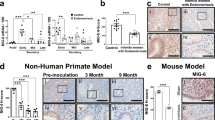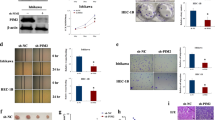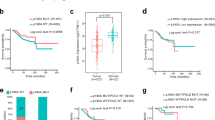Abstract
Endometrial cancer is the most common malignancy of the female genital tract. Progesterone (P4) has been used for several decades in endometrial cancer treatment, especially in women who wish to retain fertility. However, it is unpredictable which patients will respond to P4 treatment and which may have a P4-resistant cancer. Therefore, identifying the mechanism of P4 resistance is essential to improve the therapies for endometrial cancer. Mitogen-inducible gene 6 (Mig-6) is a critical mediator of progesterone receptor (PGR) action in the uterus. In order to study the function of Mig-6 in P4 resistance, we generated a mouse model in which we specifically ablated Mig-6 in uterine epithelial cells using Sprr2f-cre mice (Sprr2fcre+Mig-6f/f). Female mutant mice develop endometrial hyperplasia due to aberrant phosphorylation of signal transducers and activators of transcription 3 (STAT3) and proliferation of the endometrial epithelial cells. The results from our immunoprecipitation and cell culture experiments showed that MIG-6 inhibited phosphorylation of STAT3 via protein interactions. Our previous study showed P4 resistance in mice with Mig-6 ablation in Pgr-positive cells (Pgrcre/+Mig-6f/f). However, Sprr2fcre+Mig-6f/f mice were P4-responsive. P4 treatment significantly decreased STAT3 phosphorylation and epithelial proliferation in the uterus of mutant mice. We showed that Mig-6 has an important function of tumor suppressor via inhibition of STAT3 phosphorylation in uterine epithelial cells, and the antitumor effects of P4 are mediated by the endometrial stroma. These data help to develop a new signaling pathway in the regulation of steroid hormones in the uterus, and to overcome P4 resistance in human reproductive diseases, such as endometrial cancer.
This is a preview of subscription content, access via your institution
Access options
Subscribe to this journal
Receive 50 print issues and online access
$259.00 per year
only $5.18 per issue
Buy this article
- Purchase on Springer Link
- Instant access to full article PDF
Prices may be subject to local taxes which are calculated during checkout







Similar content being viewed by others
References
Siegel RL, Miller KD, Jemal A . Cancer statistics, 2016. CA Cancer J Clin 2016; 66: 7–30.
Di Cristofano A, Ellenson LH . Endometrial carcinoma. Annu Rev Pathol 2007; 2: 57–85.
Kurman RJ, Kaminski PF, Norris HJ . The behavior of endometrial hyperplasia. A long-term study of "untreated" hyperplasia in 170 patients. Cancer 1985; 56: 403–412.
Critchley HO, Saunders PT . Hormone receptor dynamics in a receptive human endometrium. Reprod Sci 2009; 16: 191–199.
Graham JD, Clarke CL . Physiological action of progesterone in target tissues. Endocr Rev 1997; 18: 502–519.
Rubel CA, Jeong JW, Tsai SY, Lydon JP, Demayo FJ . Epithelial-stromal interaction and progesterone receptors in the mouse uterus. Semin Reprod Med 2010; 28: 27–35.
Lee JH, Kim TH, Oh SJ, Yoo JY, Akira S, Ku BJ et al. Signal transducer and activator of transcription-3 (Stat3) plays a critical role in implantation via progesterone receptor in uterus. FASEB J 2013; 27: 2553–2563.
Franco HL, Rubel CA, Large MJ, Wetendorf M, Fernandez-Valdivia R, Jeong JW et al. Epithelial progesterone receptor exhibits pleiotropic roles in uterine development and function. FASEB J 2012; 26: 1218–1227.
Kurita T, Lee KJ, Cooke PS, Lydon JP, Cunha GR . Paracrine regulation of epithelial progesterone receptor and lactoferrin by progesterone in the mouse uterus. Biol Reprod 2000; 62: 831–838.
Kim JJ, Kurita T, Bulun SE . Progesterone action in endometrial cancer, endometriosis, uterine fibroids, and breast cancer. Endocr Rev 2013; 34: 130–162.
Hahn HS, Yoon SG, Hong JS, Hong SR, Park SJ, Lim JY et al. Conservative treatment with progestin and pregnancy outcomes in endometrial cancer. Int J Gynecol Cancer 2009; 19: 1068–1073.
Yang S, Thiel KW, Leslie KK . Progesterone: the ultimate endometrial tumor suppressor. Trends Endocrinol Metab 2011; 22: 145–152.
Decruze SB, Green JA . Hormone therapy in advanced and recurrent endometrial cancer: a systematic review. Int J Gynecol Cancer 2007; 17: 964–978.
van Laar T, Schouten T, van der Eb AJ, Terleth C . Induction of the SAPK activator MIG-6 by the alkylating agent methyl methanesulfonate. Mol Carcinog 2001; 31: 63–67.
Zhang YW, Vande Woude GF . Mig-6, signal transduction, stress response and cancer. Cell Cycle 2007; 6: 507–513.
Wick M, Burger C, Funk M, Muller R . Identification of a novel mitogen-inducible gene (mig-6): regulation during G1 progression and differentiation. Exp Cell Res 1995; 219: 527–535.
Fiorini M, Ballaro C, Sala G, Falcone G, Alema S, Segatto O . Expression of RALT, a feedback inhibitor of ErbB receptors, is subjected to an integrated transcriptional and post-translational control. Oncogene 2002; 21: 6530–6539.
Lin CI, Du J, Shen WT, Whang EE, Donner DB, Griff N et al. Mitogen-inducible gene-6 is a multifunctional adaptor protein with tumor suppressor-like activity in papillary thyroid cancer. J Clin Endocrinol Metab 2011; 96: E554–E565.
Reschke M, Ferby I, Stepniak E, Seitzer N, Horst D, Wagner EF et al. Mitogen-inducible gene-6 is a negative regulator of epidermal growth factor receptor signaling in hepatocytes and human hepatocellular carcinoma. Hepatology 2010; 51: 1383–1390.
Ying H, Zheng H, Scott K, Wiedemeyer R, Yan H, Lim C et al. Mig-6 controls EGFR trafficking and suppresses gliomagenesis. Proc Natl Acad Sci USA 2010; 107: 6912–6917.
Anastasi S, Sala G, Huiping C, Caprini E, Russo G, Iacovelli S et al. Loss of RALT/MIG-6 expression in ERBB2-amplified breast carcinomas enhances ErbB-2 oncogenic potency and favors resistance to Herceptin. Oncogene 2005; 24: 4540–4548.
Duncan CG, Killela PJ, Payne CA, Lampson B, Chen WC, Liu J et al. Integrated genomic analyses identify ERRFI1 and TACC3 as glioblastoma-targeted genes. Oncotarget 2010; 1: 265–277.
Zhang YW, Staal B, Su Y, Swiatek P, Zhao P, Cao B et al. Evidence that MIG-6 is a tumor-suppressor gene. Oncogene 2007; 26: 269–276.
Jeong JW, Lee HS, Lee KY, White LD, Broaddus RR, Zhang YW et al. Mig-6 modulates uterine steroid hormone responsiveness and exhibits altered expression in endometrial disease. Proc Natl Acad Sci USA 2009; 106: 8677–8682.
Kim TH, Lee DK, Cho SN, Orvis GD, Behringer RR, Lydon JP et al. Critical tumor suppressor function mediated by epithelial Mig-6 in endometrial cancer. Cancer Res 2013; 73: 5090–5099.
Kim TH, Franco HL, Jung SY, Qin J, Broaddus RR, Lydon JP et al. The synergistic effect of Mig-6 and Pten ablation on endometrial cancer development and progression. Oncogene 2010; 29: 3770–3780.
Pirone DM, Carter DE, Burbelo PD . Evolutionary expansion of CRIB-containing Cdc42 effector proteins. Trends Genet 2001; 17: 370–373.
Makkinje A, Quinn DA, Chen A, Cadilla CL, Force T, Bonventre JV et al. Gene 33/Mig-6, a transcriptionally inducible adapter protein that binds GTP-Cdc42 and activates SAPK/JNK. A potential marker transcript for chronic pathologic conditions, such as diabetic nephropathy. Possible role in the response to persistent stress. J Biol Chem 2000; 275: 17838–17847.
Furtek SL, Backos DS, Matheson CJ, Reigan P . Strategies and approaches of targeting STAT3 for cancer treatment. ACS Chem Biol 2016; 11: 308–318.
Xiong A, Yang Z, Shen Y, Zhou J, Shen Q . Transcription factor STAT3 as a novel molecular target for cancer prevention. Cancers 2014; 6: 926–957.
Yu H, Kortylewski M, Pardoll D . Crosstalk between cancer and immune cells: role of STAT3 in the tumour microenvironment. Nat Rev Immunol 2007; 7: 41–51.
Bromberg JF, Wrzeszczynska MH, Devgan G, Zhao Y, Pestell RG, Albanese C et al. Stat3 as an oncogene. Cell 1999; 98: 295–303.
Chen CL, Hsieh FC, Lieblein JC, Brown J, Chan C, Wallace JA et al. Stat3 activation in human endometrial and cervical cancers. Br J Cancer 2007; 96: 591–599.
Wang X, Crowe PJ, Goldstein D, Yang JL . STAT3 inhibition, a novel approach to enhancing targeted therapy in human cancers (review). Int J Oncol 2012; 41: 1181–1191.
Contreras CM, Akbay EA, Gallardo TD, Haynie JM, Sharma S, Tagao O et al. Lkb1 inactivation is sufficient to drive endometrial cancers that are aggressive yet highly responsive to mTOR inhibitor monotherapy. Dis Models Mech 2010; 3: 181–193.
Ferby I, Reschke M, Kudlacek O, Knyazev P, Pante G, Amann K et al. Mig6 is a negative regulator of EGF receptor-mediated skin morphogenesis and tumor formation. Nat Med 2006; 12: 568–573.
Ambros RA . Simple hyperplasia of the endometrium: an evaluation of proliferative activity by Ki-67 immunostaining. Int J Gynecol Pathol 2000; 19: 206–211.
Li L, Shaw PE . Autocrine-mediated activation of STAT3 correlates with cell proliferation in breast carcinoma lines. J Biol Chem 2002; 277: 17397–17405.
Cheng JG, Chen JR, Hernandez L, Alvord WG, Stewart CL . Dual control of LIF expression and LIF receptor function regulate Stat3 activation at the onset of uterine receptivity and embryo implantation. Proc Natl Acad Sci USA 2001; 98: 8680–8685.
Daikoku T, Ogawa Y, Terakawa J, Ogawa A, DeFalco T, Dey SK . Lactoferrin-iCre: a new mouse line to study uterine epithelial gene function. Endocrinology 2014; 155: 2718–2724.
Lin L, Liu A, Peng Z, Lin HJ, Li PK, Li C et al. STAT3 is necessary for proliferation and survival in colon cancer-initiating cells. Cancer Res 2011; 71: 7226–7237.
Lydon JP, DeMayo FJ, Funk CR, Mani SK, Hughes AR, Montgomery CA Jr. et al. Mice lacking progesterone receptor exhibit pleiotropic reproductive abnormalities. Genes Dev 1995; 9: 2266–2278.
Jemal A, Siegel R, Ward E, Murray T, Xu J, Smigal C et al. Cancer statistics, 2006. CA Cancer J Clin 2006; 56: 106–130.
Bovicelli A, D'Andrilli G, Giordano A, De Iaco P . Conservative treatment of early endometrial cancer. J Cell Physiol 2013; 228: 1154–1158.
Kaunitz AM . Injectable depot medroxyprogesterone acetate contraception: an update for U.S. clinicians. Int J Fertil Womens Med 1998; 43: 73–83.
Huet-Hudson YM, Andrews GK, Dey SK . Cell type-specific localization of c-myc protein in the mouse uterus: modulation by steroid hormones and analysis of the periimplantation period. Endocrinology 1989; 125: 1683–1690.
Kim BG, Yoo JY, Kim TH, Shin JH, Langenheim JF, Ferguson SD et al. Aberrant activation of signal transducer and activator of transcription-3 (STAT3) signaling in endometriosis. Hum Reprod 2015; 30: 1069–1078.
Ishibashi H, Suzuki T, Suzuki S, Moriya T, Kaneko C, Takizawa T et al. Sex steroid hormone receptors in human thymoma. J Clin Endocrinol Metab 2003; 88: 2309–2317.
Lee JH, Kim TH, Oh SJ, Yoo JY, Akira S, Ku BJ et al. Signal transducer and activator of transcription-3 (Stat3) plays a critical role in implantation via progesterone receptor in uterus. FASEB J 2013; 27: 2553–2563.
Acknowledgements
We would like to thank Dr Diego H Castrillon (University of Texas Southwestern Medical Center, Dallas, TX, USA) for Sprr2f-cre mice. We would also like to thank Hanna E Teasley and Paige Wells for manuscript preparation. This work was supported by America Cancer Society, RSG-12-084-01-TBG and National Institutes of Health (NIH, HD084478) to JWJ and by Basic Science Research Program through the National Research Foundation of Korea (NRF) funded by the Ministry of Education, Science and Technology (NRF-2016R1D1A1B03934346) to JYY.
Author information
Authors and Affiliations
Corresponding authors
Ethics declarations
Competing interests
The authors declare no conflict of interest.
Rights and permissions
About this article
Cite this article
Yoo, JY., Yang, W., Lee, J. et al. MIG-6 negatively regulates STAT3 phosphorylation in uterine epithelial cells. Oncogene 37, 255–262 (2018). https://doi.org/10.1038/onc.2017.335
Received:
Revised:
Accepted:
Published:
Issue Date:
DOI: https://doi.org/10.1038/onc.2017.335
This article is cited by
-
Selumetinib overcomes gefitinib primary and acquired resistance by regulating MIG6/STAT3 in NSCLC
Archives of Pharmacal Research (2023)
-
Loss of MIG-6 results in endometrial progesterone resistance via ERBB2
Nature Communications (2022)
-
MIG-6 suppresses endometrial epithelial cell proliferation by inhibiting phospho-AKT
BMC Cancer (2018)



